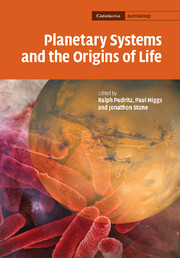Book contents
- Frontmatter
- Contents
- List of contributors
- Preface
- Part I Planetary systems and the origins of life
- 1 Observations of extrasolar planetary systems
- 2 The atmospheres of extrasolar planets
- 3 Terrestrial planet formation
- 4 From protoplanetary disks to prebiotic amino acids and the origin of the genetic code
- 5 Emergent phenomena in biology: the origin of cellular life
- Part II Life on Earth
- Part III Life in the Solar System?
- Index
4 - From protoplanetary disks to prebiotic amino acids and the origin of the genetic code
Published online by Cambridge University Press: 13 August 2009
- Frontmatter
- Contents
- List of contributors
- Preface
- Part I Planetary systems and the origins of life
- 1 Observations of extrasolar planetary systems
- 2 The atmospheres of extrasolar planets
- 3 Terrestrial planet formation
- 4 From protoplanetary disks to prebiotic amino acids and the origin of the genetic code
- 5 Emergent phenomena in biology: the origin of cellular life
- Part II Life on Earth
- Part III Life in the Solar System?
- Index
Summary
Introduction
The robust formation of planets as well as abundant sources of water and organic molecules are likely to be important prerequisites for the wide-spread appearance of life in the cosmos. The nebular hypothesis of Kant and Laplace was the first to propose that the formation of planets occurs in gaseous disks around stars. The construction of new infrared and submillimetre observatories over the last decade and a half has resulted in the discovery of protoplanetary discs around most, if not all, forming stars regardless of their mass (e.g., reviews by Meyer et al. (2006), Dutrey et al. (2006)). The recent discoveries of extrasolar planets in over a hundred planetary systems provides good evidence that Jovian planets, at least, may be relatively abundant around solar-like stars (see Chapter 1). These results beg the question of whether protoplanetary disks are also natural settings for the manufacture of the molecular prerequisites for life. Life requires water and organic molecules such as amino acids, sugars, nucleobases, and lipids as building blocks out of which biological macromolecules and cellular structures are made, and many of these can be manufactured in protoplanetary disks.
In the first part of this chapter we review the properties of protoplanetary disks and how planets are believed to form within them. We then consider the evidence that these disks may be a major source of the water and biomolecules available for the earliest life, as on the Earth.
- Type
- Chapter
- Information
- Planetary Systems and the Origins of Life , pp. 62 - 88Publisher: Cambridge University PressPrint publication year: 2007
- 4
- Cited by

